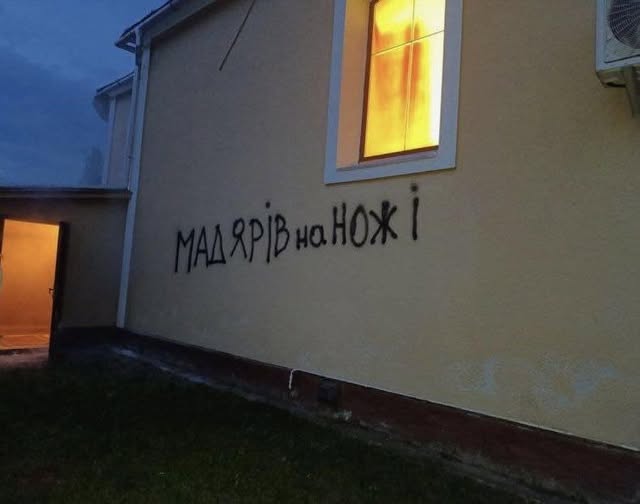Anti-Hungarian hate graffiti and arson in Ukraine: A coordinated false flag operation involving the Orbán Cabinet?

On the night of 16 July, in the village of Palágykomoróc—located in Ukraine’s Transcarpathian region—someone vandalised the local Greek Catholic church. The perpetrator, a 28-year-old local man, broke into the church grounds, set fire to the sacristy door, and spray-painted provocative, anti-Hungarian slogans on the building’s façade.
Anti-Hungarian hate inscription and arson attack
The Hungarian government responded to the incident with unusual speed and unanimity. The state’s communications machinery was already in motion early that morning; in fact, a post about the attack appeared on the Prime Minister’s Facebook page less than 45 minutes after the government-aligned outlet Mandiner first reported it. In addition to launching diplomatic measures, the government also provided financial assistance—within just a few hours.
Meanwhile, several experts—including political scientist András Rácz in a Facebook post—began questioning how such precise information could have been obtained so quickly in relation to a fresh case of arson and vandalism, especially one occurring in a foreign country. Their doubts raise serious concerns.
- Shocking: Hungarians see Ukraine as nearly as big a threat as Russia

Ukrainian authorities apprehended the suspect within days: a 28-year-old local man who now faces formal charges of hate speech and intentional property damage. According to Telex, he was placed in pre-trial detention but may be released on bail, according to the Transcarpathian police. During the investigation, officers searched his residence and seized mobile phones and other potential evidence. One aim of the inquiry is to determine whether he acted alone or had links to other—possibly political—actors.
Unusual circumstances surrounding the attack
András Rácz highlighted a particularly striking detail: a photo of the anti-Hungarian graffiti became the defining image of the attack in the Hungarian press and helped shape the government’s narrative. However, it has since emerged that no other media outlet or source had access to the image. Ukrainian authorities reportedly removed the graffiti within hours—repainting the church façade the same night. No other media outlet managed to document the slogans, and both local and international agencies relied exclusively on the image released by the Orbán government.
- Government says we should “fear” the Ukrainian guest workers, but they are actually leaving Hungary
Though Mandiner’s article appeared to be the first media report on the incident, the photo published with it was a cropped, lower-resolution version of the one later shared by Viktor Orbán. This suggests the original image did not originate from the media, but was instead sent directly to the government, which then circulated it among government-aligned outlets.
This chain of events is not only supported by differences in image editing but also by the speed of the government’s reaction. The Hungarian Foreign Ministry summoned Ukraine’s ambassador to Budapest that same morning, and funds for restoring the church were transferred that very day. Such an immediate and coordinated diplomatic response seems unlikely in the case of a surprise discovery—it suggests prior knowledge or a prearranged plan.
Palágykomoróc is a tiny village in Transcarpathia with only a few hundred residents. After the fire, border patrol agents arrived quickly, followed by Ukrainian police and intelligence officers. Authorities sealed off the area. The fire caused minimal damage, and the slogans were removed almost immediately. All of this implies that the now-iconic photograph could only have been taken within the first few minutes—by someone who either knew the attack was coming or was directly involved.

False flag operation involving the Orbán Cabinet?
This suspicion takes on greater weight if, in fact, the photo didn’t simply fall into the hands of the Hungarian government by chance—but was deliberately provided to it. The government was so confident in the image’s authenticity that it disseminated it widely without waiting for verification from independent sources.
Government statements and pro-government media outlets further escalated tensions, repeatedly claiming that the Transcarpathian church had been “set on fire”—even though only a door was burned. The objective appears clear: to present the event as dramatically as possible to Hungarian public opinion. Ukrainian authorities maintain that the attack was intended to stir unrest in the region and be exploited for propaganda—and that is precisely what transpired.

Several independent analysts—including Anton Shekhovtsov, an expert in post-Soviet nationalism—suggested the day after the incident that it may have been a “false flag” operation driven by external interests, possibly Hungarian or Russian. But the most troubling question is not the origin of the photo, nor the pace of diplomatic action—it is the motive behind it all.
According to András Rácz, if the Hungarian government was indeed involved, it would indicate a willingness to endanger ethnic Hungarians living beyond the country’s borders in pursuit of domestic political objectives.
To read or share this article in Hungarian, click here: Helló Magyar
Click for more news concerning the Transcarpathian Hungarian community.







